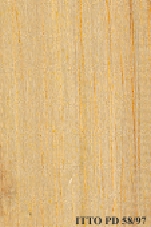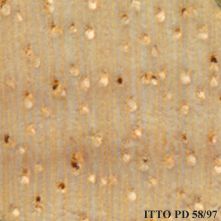
PARASOLIER (Musanga cecropioides)
Trade Name
Parasolier
Scientific Name
Musanga cecropioides R.Br.
Family
CECROPIACEAE
Common Names
Umbrella tree (Nigeria); Parasolier (Côte d`Ivoire); Senga (Zaire); N'senga (Zaire); Asseng (Gabon); Senga (Congo); N'senga (Congo); Asseng (Cameroon); Wunsone; Unson; Uno; Umbrella tree; Ukporwe; Ukhorube; Ufogho; Tshilombelombe; Tshilombela; Tshabi; Siang; Senga; Schirmbaum; Ro; Peindo; Otumbi; Ote; Osenge; Oro; Ojamba; Ogohen; Ofika; Odzuma; Odwumafufuo; Odwuma; Ngovui; Ngogho; N`senga; Musanga; Mulamba; Moussinga; Mouin; Loho; Lisengi; Kigere; Kaliba; Juna; Juma; Ikumbu; Ikomba; Guima; Glu; Gbawo; Ekombo; Ekomba; Egunli; Eguni; Egui; Egimamfuk; Egeun; Egbesu; Dzama; Dwuma; Djunia; Diseng; Corkwood; Congo-congo; Combo-combo; Butwiome; Bossengue; Bokuibe; Bokombo; Asseng; Assang; Assan; An`fekan; Amaya; Ajama; Agyemkama; Agoumi; Agbome; Aga umbrella tree; African corkwood; Abome; Govwi (Liberia); Doe (Liberia); N`Govoge (Sierra Leone); Parasolier
Scientific Name Synonyms
Musanga smithii R. Br.
Description Of The Tree
Botanical Description
The tree may reach up to 30 m, with a diameter up to 120 cm. The bole is straight and slender, from 8 to 15 m long.
Natural Habitat
Musanga cecropioides is typical of secondary forests, common on old farms in closed forests.
Natural Distribution
West, Central and East Africa, from Sierra Leone to Uganda.
Wood Identification
Anatomic Description Of Wood
Wood diffuse porous. Occasionally vessels exclusively solitary (over 90%). Tangential diameter of vessel lumina 200 micras or more (large). Tyloses thin walled. Non-vestured pits. Vessels per mm2 less than 6 (rare). Simple perforation plates. Vessel-ray pits lar Paratracheal axial parenchyma thin vasicentric. Occasionally prismatic crystals in non-chambered axial parenchyma cells. 3 to 4 cells per parenchyma strand. 4 to 10 rays per mm (medium). Rays non-storied. Rays 1 to 4 seriate. Prismatic crystals in radial alignment in procumbent ray cells (chambered cells). Homogeneous rays and/or sub-homogeneous rays (all ray cells procumbent). Body ray cells procumbent with mostl Non-septate fibers. Fibers with simple to minutely bordered pits.
-
 Wood Macro Photo Tangential Plane
Wood Macro Photo Tangential Plane
-
 Wood Micro Photo Of Transversal Section
Wood Micro Photo Of Transversal Section
Availability
Cites Status
Unrestricted
General Wood Description
Color
The heartwood is pale yellow, pale brown or white, turning to a pale yellow-white with age, it is not clearly demarcated.
COLOR INDEX (1=Black, 7=Light yellow,white)
7
Grain
Straight; grain has no particular influence on drying, machining and finishing qualities.
Texture
The texture of the wood is frequently coarse.
Luster
The surface of the wood is naturally low in luster.
Natural Durability
Not durable; important risks of decay attacks at any processing step, from logs up to final products. It must receive preservative treatment. Sensible to termites attack. The heartwood is sensible to Lyctus attacks.
Natural durability index (1= Very high durability, 7=Vey low durability)
5
Internal Growth Stresses
For this species no growth stresses are reported.
Silica Content
Silica Content: Negligible contents of silica are found in timber of this species. Amounts over 0.05% may affect the wood processing. Silica Value: 0
Resistance To Impregnation
Easy to treat with a full penetration of the preservative products using vacuum-pressure method.
Wood Physical Properties
Basic Density or Specific Gravity (O.D. weight/vol. green) (g/cm³)
0.25
Air-dry Density (Weight and volume at 12%MC) (g/cm³)
0.26
Total shrinkage Tangential (Saturated to 0%MC) (%)
6.5
Total shrinkage Radial (Saturated to 0%MC) (%)
2.3
Drying Defects
Ease of Drying: Drying is very slow and difficult to perform; defects are frequent. Drying Defects: Risks of checks and distortions.
Recommended Dry Kiln Schedule
FR-2
Dimensional stability ratio (Total Tangential Shrinkage %/Total Radial Shrinkage %)
2.9
Wood Chemical Properties
Wood Mechanical Properties
Bending Strength (MOR),12%MC (kgf/cm²)
347
Stiffness (MOE) 12%MC (kgf/cm²)
58593
Compression parallel to fiber 12%MC (kgf/cm²)
209
Compression perpendicular to fiber 12%MC (kgf/cm²)
19
Shear strength radial 12%MC (kgf/cm²)
44
Janka hardness (side) 12%MC (kgf)
79
Janka hardness (end grain) 12%MC (kgf)
138
Workability
Sawing
It is easy to saw.
Rotary Veneer Cutting
Not suitable for veneering.
Sliced Veneer
Not suitable for veneering.
Blunting Effect
Slight blunting effect; ordinary tools can be used for sawing and machining.
Machining
Machining of this species is reportedly easy.
Planing
Easy; no particular problems.
Moulding
Moderately easy; tools must be cautiously sharpened.
Boring
Moderately easy; tools must be cautiously sharpened.
Mortising
Moderately easy; tools must be cautiously sharpened.
Nailing
Easy to perform but low nails holding.
Gluing
Glues well if basic gluing technical rules are followed.
Sanding
Particular care is needed to avoid woolly aspect of the surface.
Polishing
Needs pre-coating.
Response To Hand Tools
No particular problems.
REFERENCED USES
End Uses Summary
FURNITURE AND CABINETS, common furniture, PACKING, light packing, OTHER AND MUSICAL INSTRUMENTS, door core, coffin, scale model
Furniture Cabinets
- 21 - Tropical timbers of the world. Part III-Southeast Asian and Oceanian Species.
Furniture, Common
- 23 - Handbook of Hardwoods
Packing
- 45 - Recopilación y Análisis de Estudios Tecnológicos de Maderas Peruanas
Light Packing
- 46 - ECUADOR, Inventario y Aprovechamiento de los Bosques del Sur Ecuatoriano
Door Cores
- 76 - Descripción General y Anatómica de 105 Maderas del Grupo Andino.
Coffin
- 78 - Amazonian Timbers for the International Market
Scale Models
- 83 - Algunas caracteristicas fisicomecanicas de la madera de tres especies de la cordillera NeoVolcanica
Please Provide Information To View Producer Information